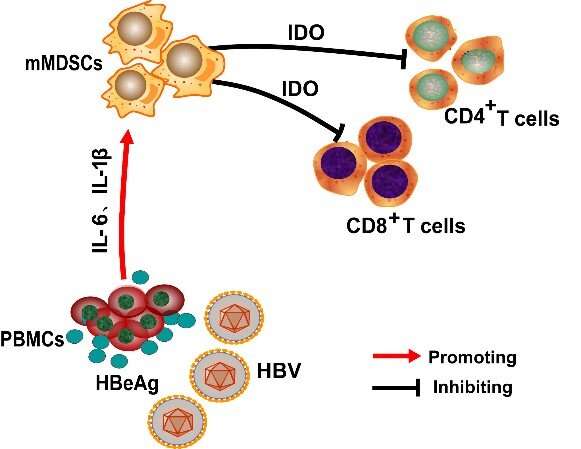How the hepatitis B virus establishes persistent infection

New research sheds light on how a hepatitis B viral protein stimulates the expansion of immune cells that impair antiviral responses, according to a study published April 18 in the open-access journal PLOS Pathogens by Haitao Guo of the Indiana University School of Medicine, Bin Wang and Jiming Zhang of Fudan University, and colleagues. The findings potentially explain how the hepatitis B virus (HBV) establishes and maintains chronic infection, and could lead to the development of novel therapeutic strategies.
HBV is a blood-borne pathogen that chronically infects approximately 350 million people worldwide, and more than 780,000 patients die annually due to HBV-related liver diseases. Chronic HBV infection is associated with impaired virus-specific T-cell responses. Myeloid-derived suppressor cells (MDSCs) are immune cells known to play a critical role in impairing antiviral T-cell responses. In addition, the hepatitis B e-antigen (HBeAg) - a hepatitis B viral protein—may represent a viral strategy to establish persistent infection, but the mechanism remains largely unknown. In the new study, the researchers examined the mechanisms underlying the expansion of MDSCs and the suppression of T-cell responses in persistent HBV infection.
The researchers analyzed the circulation frequency of MDSCs in 164 patients with chronic HBV infection and 70 healthy donors. They found that the frequency of circulating MDSCs in HBeAg-positive patients is higher than in HBeAg-negative patients. Moreover, HBeAg induced the expansion of MDSCs through the upregulation of a molecule called indoleamine-2, 3-dioxygenase (IDO), which plays a critical role in the suppression of T-cell proliferation. According to the authors, the findings suggest a novel mechanism in which HBeAg-induced MDSC expansion impairs T-cell function through the IDO pathway and favors the establishment of persistent HBV infection. The HBeAg-MDSC-IDO axis may therefore serve as an immunotherapeutic target of chronic hepatitis B.
The authors add, "HBV has may tricks to mess up the host immune system for maintaining a persistent infection, HBeAg is one of the culprits. Breaking the HBeAg-IDO-MDSC nexus may hold promise for developing new HBV therapeutics to treat HBeAg-positive patients."
More information: Yang F, Yu X, Zhou C, Mao R, Zhu M, Zhu H, et al. (2019) Hepatitis B e antigen induces the expansion of monocytic myeloid-derived suppressor cells to dampen T-cell function in chronic hepatitis B virus infection. PLoS Pathog 15(4): e1007690. doi.org/10.1371/journal.ppat.1007690


















